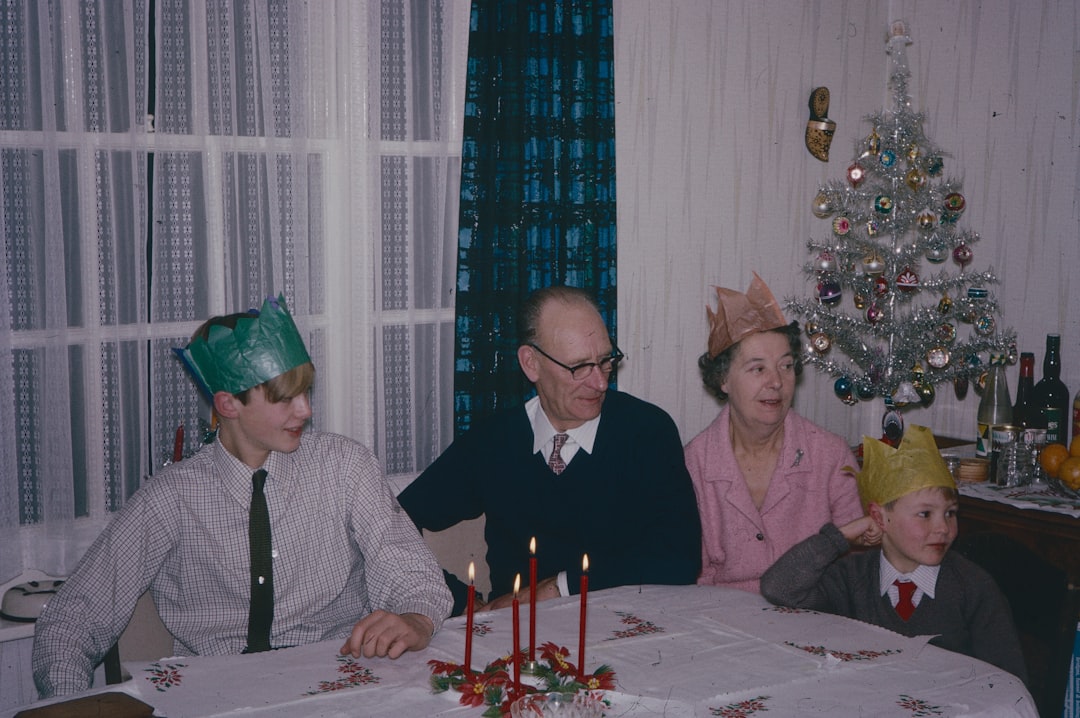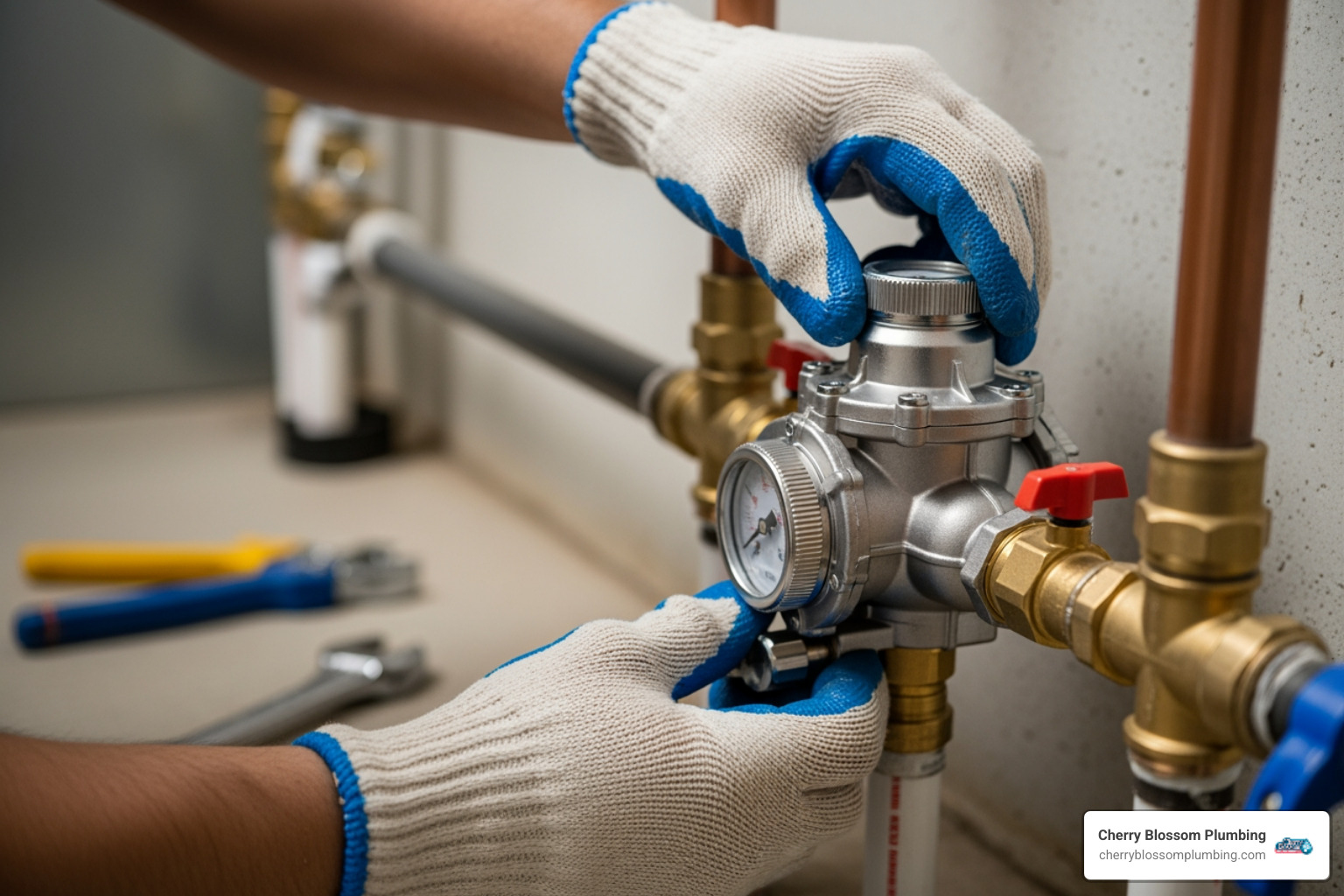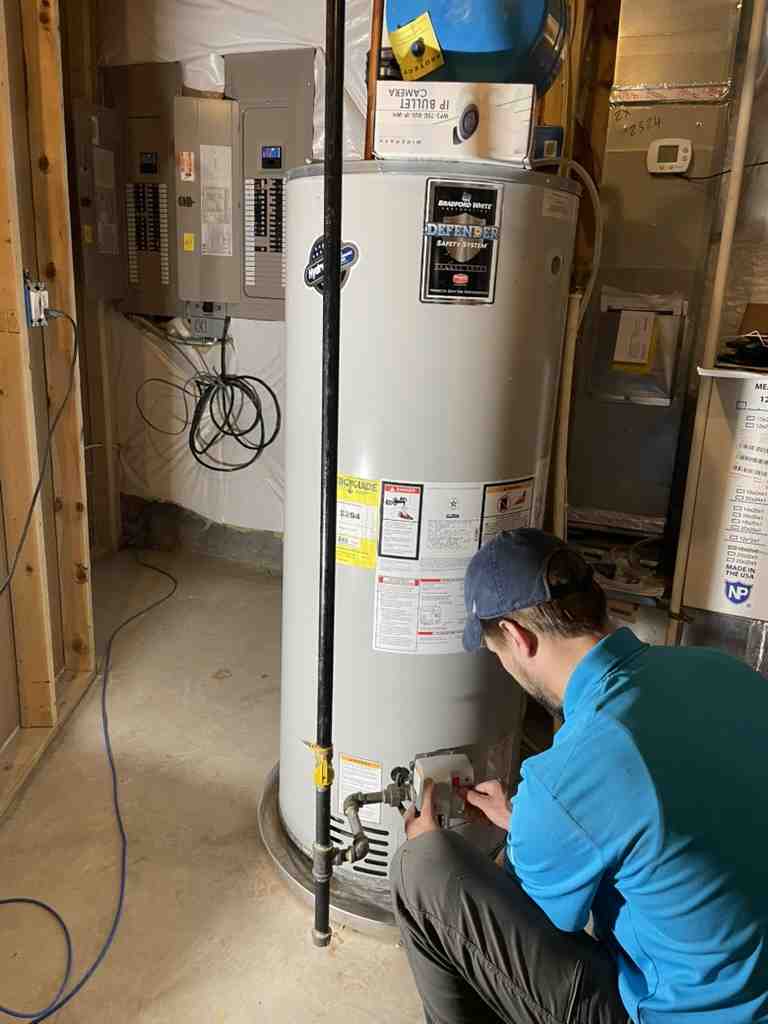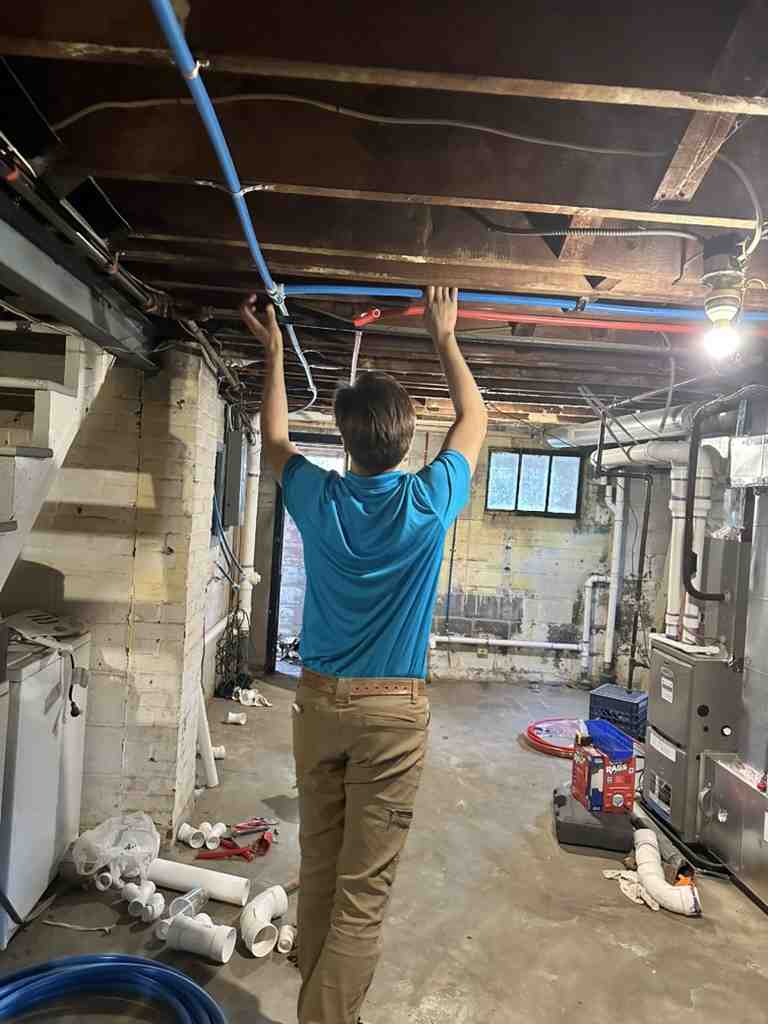
The Hidden Plumbing Problem in Northern Virginia's Historic Homes
Galvanized pipe inspection northern va is essential for homeowners in older properties who want to avoid water quality issues, costly leaks, and plumbing emergencies. If your home was built before the 1970s, your pipes are likely nearing the end of their useful life—even if everything seems fine on the surface.
Quick Answer: What You Need to Know About Galvanized Pipe Inspection
- Who needs it: Homes built before 1970, especially those 60+ years old
- Why it matters: Galvanized pipes corrode from the inside, causing rust buildup, lead contamination, and leaks
- Common signs: Discolored water, low water pressure, visible rust, frequent leaks
- What to do: Schedule a professional inspection that includes visual assessment, water pressure testing, and camera inspection
- Typical lifespan: 80-100 years, but problems often start after 40-50 years
Many of Northern Virginia's historic homes in Old Town Alexandria, Arlington, and beyond still have galvanized steel pipes from the 1920s-1960s. These pipes weren't built to last forever. As their protective zinc coating wears away, they corrode, collect mineral deposits, and can leach lead into your drinking water. Rusty water, low pressure, or leaks are signs your pipes may be failing behind your walls.
Learn more about common galvanized pipe problems or schedule a professional inspection with Cherry Blossom Plumbing to protect your home and family.
I'm Amanda Casteel. With years of experience helping Northern Virginia homeowners with their plumbing, I approach galvanized pipe inspection northern va with technical precision and a focus on your family's safety and peace of mind.

Why Galvanized Pipes Are a Concern for NOVA Homeowners
While galvanized pipes have a lifespan of 80-100 years, this number is misleading for Northern Virginia homeowners. Problems often begin after just 40-50 years due to our local water characteristics. By middle age, these pipes are already quietly deteriorating from the inside out.
Galvanized pipes corrode from the inside, where you can't see the damage. Their protective zinc coating erodes over decades, exposing the steel to water. This causes rust and mineral accumulation, which shrinks the pipe's interior diameter and restricts water flow. You won't notice this sneaky corrosion until the damage is significant.
One of the first signs is decreased water pressure, especially when multiple appliances are running. A shower turning into a trickle or weaker pressure upstairs are classic symptoms. These aren't minor annoyances; they indicate that mineral deposits are choking your pipes. Our guide on water pressure problems in Northern VA explains this further.
Beyond inconvenience, aging galvanized pipes bring serious health risks and the possibility of costly water damage.
The Hidden Dangers: Lead Exposure and Leaks
Surprisingly, galvanized pipes can contaminate your water with lead particles. As the zinc coating corrodes, it can release lead impurities from the zinc itself or from old solder joints. The pipes act as a reservoir, releasing lead into your drinking water. This is a serious health risk, especially for families with young children or pregnant women.
Corrosion also leads to structural failure. Pinhole leaks are common in older systems, developing in hidden spots behind walls or under floors. These leaks can drip silently for months, causing extensive damage before they're finded. A damp spot on your ceiling or a musty smell can indicate water-soaked drywall, rotted framing, and mold growth, turning a small leak into a major project. Our resource on signs of hidden leak issues in Alexandria can help you spot the signs.
How Age and Water Affect Your Pipes
Northern Virginia's water quality significantly impacts your pipes' lifespan. Our local water contains minerals like calcium and magnesium ("hard water"), which accelerate corrosion and scale buildup inside galvanized pipes. This means the 80-100 year ideal lifespan is often much shorter in reality. Your pipes' functional life—their ability to deliver clean water at good pressure—is reduced by our local water chemistry.
We recommend a yearly inspection for any home over 60 years old. Catching corrosion early, before it leads to leaks or water quality issues, can save you from bigger headaches. Regular galvanized pipe inspection northern va services let us monitor your system and help you plan for upgrades before an emergency. For a deeper dive, check out our guide on galvanized pipe problems in Northern VA.
7 Telltale Signs Your Galvanized Pipes Need an Inspection
Failing galvanized pipes usually provide warning signs before a disaster. If you notice any of these issues, it's time to schedule a galvanized pipe inspection northern va before a small problem becomes an expensive emergency.
1. Discolored or Rusty-Looking Water
Brown or yellow water is a clear sign of rust particles breaking loose from inside your pipes. This is often most noticeable on the first draw of water in the morning. You might also see reddish-brown stains on fixtures like sinks and faucets. This means the protective zinc coating has worn away and the steel is corroding.
2. Decreased Water Pressure
This is one of the most common complaints. The cause is mineral deposit buildup and rust narrowing the pipe's diameter. The problem is most obvious when multiple fixtures are running at once. Low pressure can also indicate a hidden leak. Our article on detecting hidden pipe leaks can help you learn more.
3. Visible Corrosion or Rust on Pipes
Check exposed pipes in your basement, crawl space, or under sinks for warning signs. Look for flaking metal, rust spots on exposed pipes, or a white, chalky buildup. Pay close attention to threaded joints, which often corrode first. If the outside of your pipes shows corrosion, the inside is likely much worse. For more on this, see our guide on pipe leak repair in Arlington.
4. Frequent Leaks or Drips
Frequent leaks or drips are a clear sign your galvanized pipes are failing. As the metal corrodes, it develops pinhole leaks. You might notice damp spots on walls or ceilings or smell musty odors from hidden moisture. These leaks can cause serious water damage and mold growth if not addressed. Learn more in our guide on pipe leak repair in Fairfax.
5. Inconsistent Water Temperature
If your water temperature swings wildly, your galvanized pipes could be the cause. Hot water pipes can become clogged with rust and deposits, creating a reduced flow to your water heater. This restricted flow causes temperature fluctuations and can even create a scalding risk. This is a safety concern, especially for homes with children or elderly family members.
6. Odd-Tasting or Smelling Water
A metallic taste or visible sediment in water indicates your pipes are leaching rust and minerals. This affects not just taste but overall water quality. You might also notice cloudy ice cubes or an off-taste in coffee and tea. Arlington County offers resources to help homeowners learn about local water service lines and potential material impacts.
7. Your Home's Age
If your house was built before the 1970s, it likely has galvanized pipes. Galvanized steel was the standard for water lines from the 1920s through the 1960s. While checking your home's age, be aware of other problematic materials from different eras, like polybutylene pipes or older cast-iron pipes for drains. Age alone is a compelling reason to schedule a galvanized pipe inspection northern va as a preventive measure.
The Professional Approach to Galvanized Pipe Inspection in Northern VA
A professional galvanized pipe inspection northern va is essential for protecting your family and your investment. At Cherry Blossom Plumbing, we have the tools and experience to find problems in Northern Virginia's historic properties before they become emergencies.
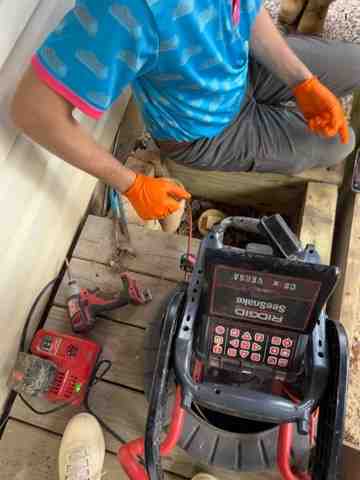
What to Expect During a Galvanized Pipe Inspection in Northern VA
Our systematic galvanized pipe inspection northern va begins with a visual assessment of all accessible pipes in your basement, crawl spaces, and under sinks. We look for rust, flaking, corrosion, and signs of leaks. Next, we conduct water pressure testing at multiple fixtures to find inconsistencies that reveal internal corrosion. We may also perform a water quality analysis to test for metallic contaminants. This initial assessment creates a roadmap for a closer look, similar to our approach with trenchless sewer repair in Northern Virginia, where we gather data before applying advanced technology.
Advanced Diagnostic Methods
Because galvanized pipes corrode internally, a visual check isn't enough. We use advanced, non-invasive technology to see inside your walls. Our primary tool is video camera inspection. We guide a small, high-resolution camera through your pipes via an existing access point, sending real-time footage to a monitor. This allows us to see rust buildup, narrowing, and pinhole leaks.
We also use steerable CCTV technology to create a detailed visual record, pinpointing blockages and assessing structural integrity without damaging your walls. This gives us undeniable evidence of your pipes' condition, allowing us to recommend the right solution, from monitoring to a full replacement. This precise approach, also used for pipe leak detection, saves homeowners from guesswork and unexpected disasters.
A professional inspection provides peace of mind with honest answers and a clear path forward.
Beyond Inspection: Pipe Replacement Options
Once we've completed a thorough galvanized pipe inspection northern va and shared the results with you, you'll have a clear picture of what's happening behind your walls. For many homeowners living with aging galvanized pipes, the conversation naturally shifts from "Can we fix this?" to "Should we replace this?" While the idea of repiping might feel overwhelming at first, I can tell you from experience that modern pipe materials offer remarkable improvements in durability, water quality, and long-term reliability—not to mention the peace of mind that comes with knowing your family's water supply is safe.
| Pipe Type | Durability | Corrosion Resistance | Lifespan (Estimated) |
|---|---|---|---|
| Galvanized Steel | Moderate (prone to internal corrosion) | Poor | 80-100 years (problems often start at 40-50) |
| Copper | Excellent (strong, rigid, resistant to UV) | Excellent | 70-80 years |
| PEX (Cross-linked Polyethylene) | Excellent (flexible, resistant to freezing) | Excellent | 50+ years |
When is Repiping the Right Choice?
I know that deciding between ongoing repairs and a full replacement isn't easy. It's a significant decision, and we want to help you make the right one for your home and budget. There are several clear indicators that point toward repiping as the smartest long-term solution.
If you're calling us out frequently for repairs—whether it's another leak, another drip, or another blockage—those service calls add up quickly. More importantly, they're often symptoms of a larger systemic problem. Patching one section of corroded pipe doesn't stop the rest from deteriorating at the same rate.
When our inspection reveals widespread corrosion throughout your plumbing system, spot repairs become a temporary fix at best. It's like patching one hole in a boat when the entire hull is compromised. We've seen this scenario many times in Northern Virginia's older homes, and the reality is that if one section has failed, others are likely close behind.
Another telltale sign is when you're experiencing low water pressure throughout your entire home, not just at one fixture. This usually means mineral buildup and corrosion have significantly narrowed your pipes' internal diameter across the system. In these cases, repiping is often the only way to truly restore the robust water flow your home deserves.
There's also a practical angle to consider. If you're already planning a remodel—whether it's a kitchen renovation, a bathroom upgrade, or a whole-house project—addressing your plumbing while walls are already open is far more efficient and less disruptive. It's the perfect opportunity to upgrade your infrastructure without the added cost of opening and closing walls twice. For more guidance on addressing pipe issues proactively, our home pipe repair guide offers helpful insights.
Modern Alternatives to Galvanized Pipes
The good news? Today's plumbing materials are light-years ahead of galvanized steel. You have several excellent options, each with distinct advantages that make them superior choices for Northern Virginia homes.
Copper pipes have been the gold standard for decades, and for good reason. They're incredibly durable, naturally resistant to corrosion, and don't leach harmful substances into your water. Copper is rigid and reliable, standing up well to our area's water conditions. Many of the homes we work on that had copper installed in the 1950s or 60s are still going strong today. It's a proven performer with an impressive track record.
PEX (cross-linked polyethylene) has become increasingly popular, and it's easy to see why. This flexible plastic tubing offers excellent resistance to corrosion, scale buildup, and even freezing—a real advantage during those occasional harsh Northern Virginia winters. Because it's flexible, installation is often quicker and less invasive. We can snake PEX through walls with fewer connections, which means fewer potential leak points. It's also quieter than copper when water flows through it, and its smooth interior surface actually improves water flow by reducing friction.
CPVC pipes (chlorinated polyvinyl chloride) represent another solid plastic alternative. They're rigid like copper but share plastic's inherent resistance to corrosion. CPVC handles high temperatures well, making it suitable for both hot and cold water lines.
The benefits of upgrading to these modern materials are tangible and immediate: improved water safety, consistent water pressure throughout your home, and the kind of long-term reliability that lets you stop worrying about your plumbing. When you replace those aging galvanized pipes, you're not just fixing a current problem—you're making a lasting investment in your home's infrastructure and your family's health and comfort.
Frequently Asked Questions about Galvanized Pipes
We hear the same questions over and over from homeowners across Alexandria, Arlington, and Falls Church—especially those who've just learned their charming historic home might have a not-so-charming plumbing problem. Let's tackle the most common concerns about galvanized pipes with straightforward answers.
How long do galvanized pipes really last in Northern Virginia?
Here's the thing: when manufacturers talk about galvanized pipes lasting 80-100 years, they're technically correct. But that doesn't mean your pipes will work well for that entire century. In our experience serving Northern Virginia homeowners, problems typically start showing up after just 40-50 years—sometimes even earlier, depending on your specific water quality and usage patterns.
The confusion comes from what "lifespan" actually means. Yes, the pipe itself might physically exist for 100 years, but its ability to deliver clean water at decent pressure? That's a different story. Northern Virginia's water quality, with its mineral content and natural hardness, accelerates the internal corrosion process. What you get is a pipe that's still hanging on the wall but is essentially a rusty, clogged tube on the inside.
If your home is 60 years or older, we strongly recommend a yearly inspection to monitor the corrosion timeline. Think of it like regular checkups at the doctor—you want to catch problems before they become emergencies.
Can you repair just one section of a galvanized pipe?
Absolutely, we can perform spot repairs on a leaking or corroded section of galvanized pipe. But I'll be honest with you: it's usually a temporary fix, not a permanent solution.
Here's why: when we connect a new pipe material like copper or PEX to your existing galvanized pipe, we're joining two different metals. This can actually speed up corrosion at that connection point through a process called galvanic action. It's like the metals don't play well together, and your old galvanized pipe takes the hit.
More importantly, if one section of your galvanized system is failing, the rest of your pipes are likely in similar condition. They've all been exposed to the same water for the same amount of time. Fixing one spot is a bit like patching one hole in a worn-out sweater—another hole is probably about to appear.
That said, spot repairs can make sense in certain situations, like buying you time to plan for a full replacement or addressing an emergency leak. A professional assessment is essential to help you understand whether a repair will genuinely serve you or if you're just postponing the inevitable. We'd rather give you solutions that offer real, lasting peace of mind.
Does homeowners insurance cover galvanized pipe replacement?
This is where things get a bit tricky, and the answer is usually "it depends on your specific policy." Most homeowners insurance policies are designed to cover sudden and accidental damage—think of a pipe that bursts and floods your basement overnight. That kind of dramatic event often qualifies for coverage, at least for the resulting water damage.
However, insurance companies typically don't cover issues that fall under gradual wear and tear or problems caused by aging infrastructure. If your galvanized pipes have been slowly corroding over decades, leading to rust, reduced water pressure, and eventual leaks, that's usually considered a maintenance issue, not an insurable event.
Here's a common scenario: if your old galvanized pipe suddenly bursts, your insurance might cover the cost of repairing your damaged floors, walls, and belongings. But the actual pipe replacement? That's often on you as the homeowner.
The best approach is to review your specific policy with your insurance provider before you have a problem. Ask them directly about coverage for aging plumbing systems and pipe replacement. This is yet another reason why proactive galvanized pipe inspection northern va matters so much—it helps you get ahead of issues before they become expensive surprises that may or may not be covered. Prevention is always cheaper than emergency repairs.
Secure Your Home's Water System
We've walked through the warning signs together—from that unsettling brown tint in your morning glass of water to the frustrating trickle in your shower. We've talked about the hidden risks lurking behind your walls, from lead contamination to those sneaky pinhole leaks that can turn into expensive nightmares. If you're living in one of Northern Virginia's beautiful older homes, especially one built before the 1970s, you now understand why a galvanized pipe inspection northern va isn't just another item on your home maintenance checklist—it's about protecting what matters most.
Your home is likely your biggest investment, and your family's health and safety are priceless. By taking a proactive approach to understanding your plumbing system's condition, you're not just avoiding the headache of emergency repairs at 2 a.m. or the shock of water damage spreading through your ceiling. You're ensuring that every time someone in your family turns on a faucet, they're getting clean, safe water. That peace of mind is worth its weight in gold.
Finding the right professionals to trust with your home's plumbing can feel overwhelming, but it doesn't have to be. As a family-owned, licensed plumbing service rooted right here in Arlington and Falls Church, VA, we at Cherry Blossom Plumbing have been serving our neighbors throughout Northern Virginia—from Alexandria and Annandale to Fairfax, McLean, Oakton, Springfield, and Vienna—with the kind of care we'd give our own homes. We bring local expertise that understands the unique challenges of our area's historic properties, combined with cutting-edge diagnostic tools like video camera inspections that reveal exactly what's happening inside your pipes.
Our commitment goes beyond just fixing problems. We pride ourselves on fast, reliable, and honest work, always explaining what we find and what it means for you in plain language. No confusing jargon, no pressure—just straightforward guidance to help you make the best decision for your home. We back everything we do with our "WOW factor" guarantee, because your satisfaction isn't just our goal; it's our promise.
Don't wait for a small issue to become a costly emergency. Take control of your home's water system today and give yourself the confidence that comes from knowing your plumbing is in great shape. Schedule your professional plumbing service today with Cherry Blossom Plumbing, and let's work together to secure a safe, efficient, and reliable water supply for your family for years to come.
Customer Testimonials
Cherry Blossom Plumbing has consistently provided top-notch service, ensuring every issue is resolved efficiently and professionally.







